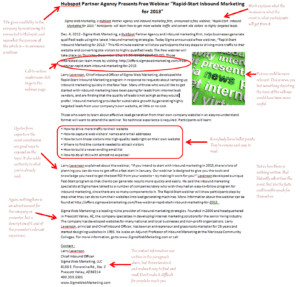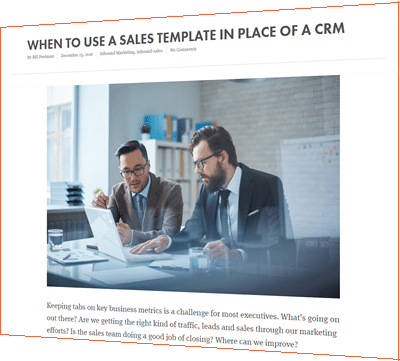 Writing new content for your website or other online sources is great and necessary for effective marketing. However, without the proper methods and best practices, all the hard work will be tossed to the wind. Today the internet is so extensive that we can’t simply follow the old saying, “If we build it, they will come.” We have to be proactive about our use of keywords in the content, meta keywords and descriptions to help search engines find our content, and links to and from our website.Last week I wrote about promoting your new offers with press releases, so this week we’ll dig in to the 17 things you need to know to write an optimized press release.
Writing new content for your website or other online sources is great and necessary for effective marketing. However, without the proper methods and best practices, all the hard work will be tossed to the wind. Today the internet is so extensive that we can’t simply follow the old saying, “If we build it, they will come.” We have to be proactive about our use of keywords in the content, meta keywords and descriptions to help search engines find our content, and links to and from our website.Last week I wrote about promoting your new offers with press releases, so this week we’ll dig in to the 17 things you need to know to write an optimized press release.
General Tips
- A press release is not a shameless plug for your company, product or service. It is an informational or educational article, simply informing the reader of something.
- Include a relevant image (even though many free press release sites don’t allow them, it’s worth it for the ones that do).
- This is for professional publication and should have a formal, professional tone to match. Don’t write like you would to your blog readers.
- Double check for correct grammar and spelling. If you can, have someone read over the article before submitting. Nothing hurts your authority like bad grammar.
- Even though this is an informational article, you still want to get something from your readers. Add a call-to-action, a link to a registration page, a blog page, a product page, etc.
Writing the Press Release
- Before starting, choose your main keyword(s) that you want to use. You’ll refer to it frequently while writing.
- Title: the length of a title varies from site to site, usually ranging from 70 to 200 characters. To be on the safe side, try to stick to about 100 characters.
- Introductory paragraph: This paragraph should be 3-5 sentences. It should explain (in one sentence) what the company does, and what the news item is (new service, webinar, etc.). In the next sentences, give just a little more detail about the date and time, what’s happening or what happened, and who’s involved. The important thing about this paragraph is keeping it clear and concise, but also summing up the contents of the rest of the article. Make sure to include the keyword or keyword phrase.
- Body paragraphs: These break down the topic and go into the details. Kuno Creative* writes, “In general, remember that most important information should be placed at the beginning of the article – information at the end is less likely to be read. Be sure to answer who, what, when, where, why, and how.” Again, include the keyword or keyword phrase once in every paragraph.
- The middle paragraphs could also include a secondary keyword phrase, which should link back to a web page containing the same phrase.
- Boiler plate: This is the last paragraph, and describes your company in 2-4 sentences. Include the most relevant information about your company, pertaining to the article subject. Make sure to include some way that readers can contact you.
Other Hints/Tips
- Many free sites don’t allow the use of HTML. Therefore, when adding links, don’t link words, just throw in the URL at the end of the sentence. An example would be “To learn more about the webinar, go to http://www.sigmawebmarketing.com/awesome-webinar.”
- When choosing where to publish, go to a site and open one of their published releases. Hover over one of the links in the article. A link will appear in the lower left corner of the browser. The URL should be a “clean link,” meaning it doesn’t have the name of the press release service anywhere in it. If it does, the SEO benefits fall and diminish the reach the press release might otherwise have.
- Link advisory
- Less than 250 words = 1 link
- 250-400 words = 2 links
- 400-750 words = 3-4 links
- Don’t write a press release more than 1000 words in length
- Always publish your press release on your website one business day before publishing it on the wire site.
- Some sites take longer to post the releases than others. Check the time span they give you and plan accordingly. If you want it to be published a week before an event or launch, submit it to the wire service a few days before then.
- Write a short blurb summing up the article that’s different from the first paragraph. Many press release services will put this at the top of your article, just under the title. Make sure the blurb is 250 characters or less.
Optimized Press Release Teardown
Click on the teardown below to see it full-sized.
 *Kuno Creative is an enterprise inbound marketing agency.
*Kuno Creative is an enterprise inbound marketing agency.





